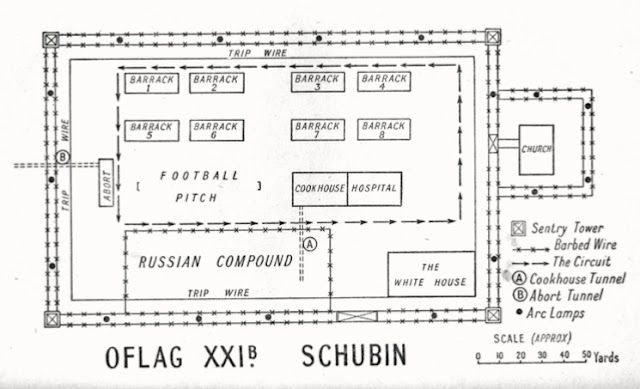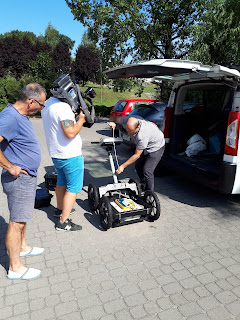What did we look for?
Below is presented the ground plan of Oflag 64 drawn based on the aerial photograph taken by British intelligence in May 1944. The buildings marked in red don’t exist anymore, while buildings marked in green still exist but were rebuilt through the years after the war. The yellow arrows indicate the potential locations of the tunnels we were looking for.
To prevent escapes ground microphones were installed in the camp in September 1942, but their location was not known to the POWs. Also shallow anti-tunnel ditches were dug between the two barracks standing highest on the hill, and the warning wire. From September to November the escape committee supported the policy build so-called blitz tunnels, which were short, shallow and very simple in construction so could be quickly finished and POWs could attempt to escape before the advent of winter weather. Three such tunnels were started. One was discovered before reached the perimeter fence, and another when it was some feet beyond the perimeter fence, both within a month of being started. One of these tunnels was starting in the chapel and the entry was under the main altar. The third was a ‘mole-type’ tunnel, made by borrowing about 18-inches below the surface without the use of shoring. It begun from vegetable garden located in the western end of camp where tall plants were growing . Thomas D. Calnan was the tunneller while Ian Cross, Robert Kee acted as watchers for him. The tunnel collapsed on Calnan and he almost lost his life.
In winter the police changed to elaborate long-term projects.
In winter the police changed to elaborate long-term projects.
Selected information about escape tunnels dug in Szubin
- Fanshave Tunnel: entrance was located in one of two lavatories in an outside buildings on the East side of the camp (building 19); chamber 14’ x 5’ x 6’; the tunnel went under the wire at a depth of 15 feet, ther rose steeply iin the remaining 30 feet to the exit located in the corner of shallow potato ditch, which begun five yards outside the perimeter fence. Work begun in January 1943, 28 POWs worked in three shifts – one shift digging, one dispersing and, and the third going in after the sand has been removed and shoring the tunnel with bed-boards. Air was supplied by pump located in chamber, one end of the air line laying in the working face and the other through the lavatory seat to the lavatory building. Illumination was provided by lamp made of tins and using margarine as fuel. The direction marked on the plan is presumed.
- Edge’s Tunnel (by Richard Edge and David Strong): entrance was in one of night latrines in barrack on the north-western part of camp. it was dug in direction of nearby wood; it was shored throughout and was fitted with electic light. The tunnel was 110 feet long and 60 beyong the perimeter fence, almost ready for escape to be made when discovered. the tunnel started in december 1942, 73 POWs worked in three shifts. Possible location in place of a non-existent building 11.
- The Cookhouse Tunnel (by Eric Williams): entrance under unused boiler in the kitchen, dug towards the south; flooded by groundwater, therefore the project was abandoned; after the tunnel was dried, the digging was resumed, the tunnel reached Russian compound, but escape through another tunnel on night 5th - 6th March, 1943 has stopped the project. The presumed location is shown below on the Oflag XXI-B ground plan – the indicated location of the tunnel (A) in fact, it could start from the building (16), because there were showers in the Hospital building addition (3). The other possible location is kitchen in building (4) which seems to be more reasonable because of required lenght of tunnel to reach the perimenetr fence towards the south.
- Panton tunnel: entrance in one of night latrines in one of baracks standing highest on the hill; dug towards the north; flooded; lack of more detailed information.
- Asselin tunnel (by Eddie Asselin): entrance in one of two lavatories in an outside buildings on the West end of the camp (building 18), it was the only tunnel in Szubin succesfully used for escape. Thirty three men escaped on the night 5th - 6th March 1943. More about the escape and the escapers one can read at here: Part One, Part Two, Part Three, and Part Four.
- Cory’s Tunnel: dug from the building (10) by American POWs (10), no detailed characteristics, except of location and direction; the escape committe decided to stop the project after the 50 officers from Stalag Luft III were executed after being recaptured. The beginning of Cory's tunnel is in place of the current Reform School building and was probably discovered during the construction works in 1969.
The photograph printed in Gazeta Pomorska newspaper in 1970 was captioned: "In the place where once was the famous tunnel, the prisoners of Oflag XXIB escaped through, the walls of a modern school are rising".




This page from book by "The Camera Became My Passport Home" by Ben van Drogenbroek with Steve Martin shows the locations of Edmund "Eddie" Asselin's tunnel (also called the "Abort" tunnel) and the tunnel of Dickie Edge. The possible locations of those two tunnels we have confirmed using Ground Penetration Radar
Video published at itvszubin:
© Mariusz Winiecki
What has been located:
The results of the research indicate the presence of underground anomalies at the presumed location of Asselin and Edge's tunnels near the current western fencing plot belonging to the Reform School. The presence of the same anomaly was also found on the outer side of the fence (during the war, this area was still within the camp). The anomalies were found in various ground cross sections along the line, which may indicate patency of the potential escape tunnels relics. In the near future, survey excavations are to be made in the place of anomalies found. This will verify the preliminary interpretation of the results of Saturday's GPR test and maybe even discover the remains of the wooden shoring of escape tunnels dug in this place during World War II.
The results of the research indicate the presence of underground anomalies at the presumed location of Asselin and Edge's tunnels near the current western fencing plot belonging to the Reform School. The presence of the same anomaly was also found on the outer side of the fence (during the war, this area was still within the camp). The anomalies were found in various ground cross sections along the line, which may indicate patency of the potential escape tunnels relics. In the near future, survey excavations are to be made in the place of anomalies found. This will verify the preliminary interpretation of the results of Saturday's GPR test and maybe even discover the remains of the wooden shoring of escape tunnels dug in this place during World War II.




Result showing ground anomalies at a depth of about 2 meters.
This page from book by "The Camera Became My Passport Home" by Ben van Drogenbroek with Steve Martin shows the locations of Edmund "Eddie" Asselin's tunnel (also called the "Abort" tunnel) and the tunnel of Dickie Edge. The possible locations of those two tunnels we have confirmed using Ground Penetration Radar
Video published at itvszubin:
© Mariusz Winiecki


















Brak komentarzy:
Prześlij komentarz